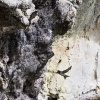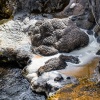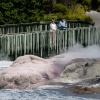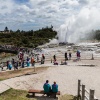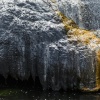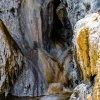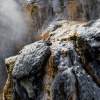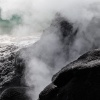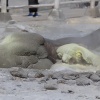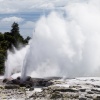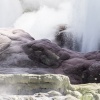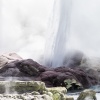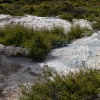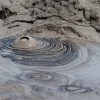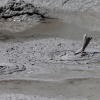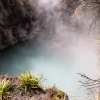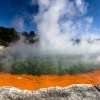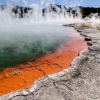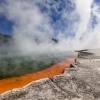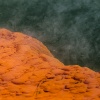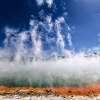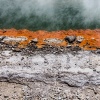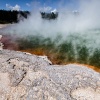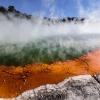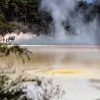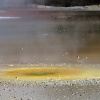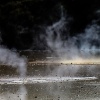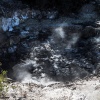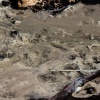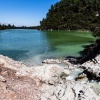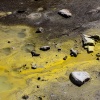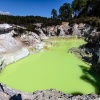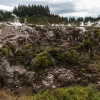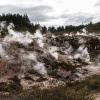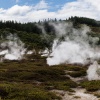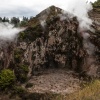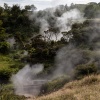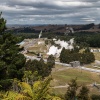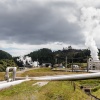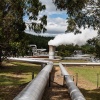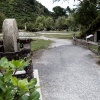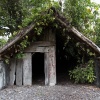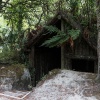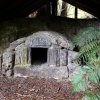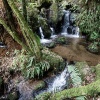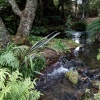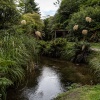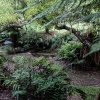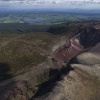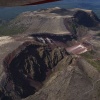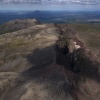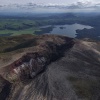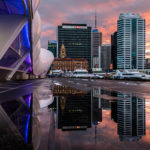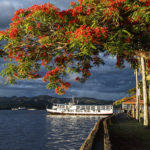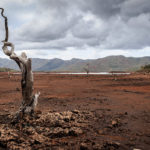Taupō – Volcanic Zone and Identity Giver for the Maōri
The Fire inside our Earth
Beside the classic Marae the Rotorua Maōri site also displays life the way it happened in ancient villages; walking through the hydrothermal park you automatically meet those replicas. Everywhere there is bubbling and hissing while vapour and sulphur dioxide rise up. Right in the middle of that, where all paths are joining, is the large geyser, often being surrounded by flocks of tourists waiting for the next eruption. The slow mass of people watches the gusher only and does not notice that only few metres from the vent swallows nest directly at the geyser rock. That’s pure evolution as individuals conquer new habitats.
The Rotorua hydrothermal system is everything but small. It reaches from the shores of Lake Rotorua through the whole city to end in the south where now Maōri culture centre and geysers can be found. Along a length of ~4 kilometres you can literally bump into a sulphuric smelling cloud almost everywhere in the city you. And this hydrothermal system is pretty much alive…! Every day it is possible that old places dry up while new places of activity emerge. Not few Maōri live in a boiling pot, that is the lakeside where hydrothermal activity is very strong. They cook with and in the hot water of the springs but also use it to warm their houses. That region looks like skin burst open, though the lakeside also has beautiful spot inviting to stay and watch hundreds of cuddly dark-blue yellow-eyed ducklings.
For New Zealand’s natives geothermal energy is of divine origin. In their mythology they prayed to make goddess Gaia (or Pele) – mistress of the Earth’s fire and officially residing in Hawaii, on Kilauea volcano – their warm up the cold islands in South Pacific Ocean. So Pele sent her force to Aotearoa, the Maōri land, where she created fire mountains as well as geothermal active areas. One of the most colourful of its kind is the Wai-O-Tapu geothermal wonderland in the east of Rotorua, being located directly at the Thermal Explorer Highway. In Maōri language Wai-O-Tapu means “sacred waters”.
The star of that gathering of hydrothermal experiences is the Champagne Pool. Its name derives from rising gas bubbles in the water but much more thrilling is its colouration: emerald green water framed by a wide orange-reddish ring. With a diameter of ~65 metres and a depth of ~62 metres it is everything but small as that scale stands for a volume of 50.000 m³. Its water temperature ranges between 70 and 80 °C. It is supersaturated with orpiment (As2S3) as well as stibnite (Sb2S3). Both metalloid compounds precipitate at the rim of the pool and produce the colour.
Vapour emitted by Champagne Pool is remarkable too. When it becomes a puppet of the wind then visitors instantly stand in more dense fog than London has on offer. The steam transports gas like carbon dioxide and also small amounts of nitrogen, methane and hydrogen sulphites. Who’s guessing that such a place is dead things wrong as the pool is habitat to an endemic bacteria only living there, that is Venenivibrio stagnispumantis. Also other geothermal appearances like the Painter’s Palette, with its differently coloured spots, and countless little mud volcanoes are interesting. Everywhere is vapour, boiling mud, appears water on the surface and is coloured soil.
At other places in New Zealand the force of Earth emerges less harmless, for example at Mount Tarawera, which is round the corner of Rotorua. In a June night in 1886 the local volcano erupted terribly wiping out all life within a distance of 6 kilometres. The bang of the eruption could be even heard in Blenheim, on the south island, and even Christchurch could enjoy the eruption’s air pollution and ash fall.
Funnily but also sadly back then the bogey of attacking Russians existed. Whole Auckland thought that the lightnings and the bang belong to a Russian battle cruiser that has nothing better to do than attacking the green grassland and forest near Tarawera… History is full of intellectually challenged warmongering puppets like Anders Fogh Rasmussen, having nothing better in mind than seeking confrontations and yelling war. The story of the eruption tells the Buried Village “Te Wairoa” in Rotorua’s south. The Eruption also wiped out so called 8th wonder of the world, that is the Pink & White Terraces, a large geothermally active sinter field.
Further south along the belt of Taupo volcanic zone lies the large Lake Taupo, a super volcano that erupted in historic times. New Zealand’s longest river, Waikato, runs through that lake as the spring of this 425 km long river is actually the Central Volcanic Plateau. There New Zealand’s most active volcanoes can be found: Tongariro, Ngauruhoe and Ruapehu, which I visited earlier in March 2013.
